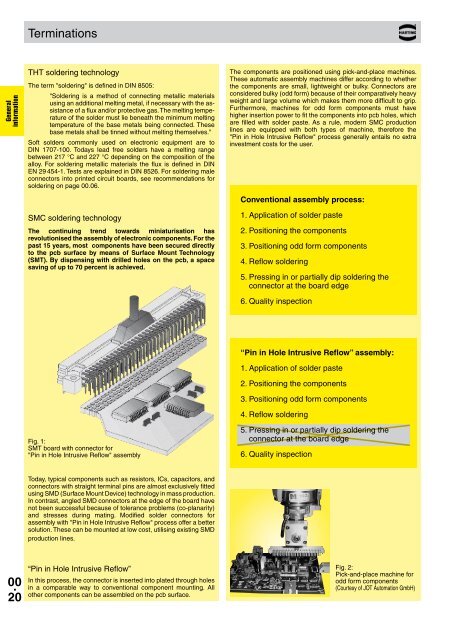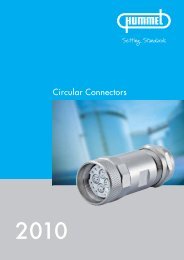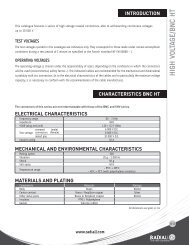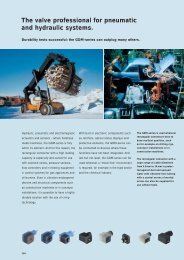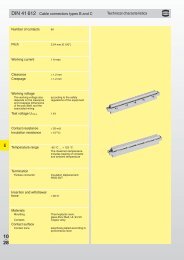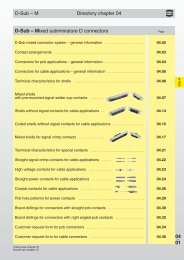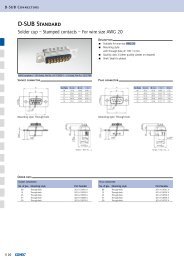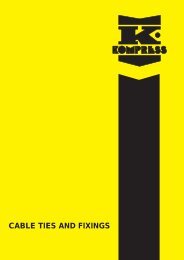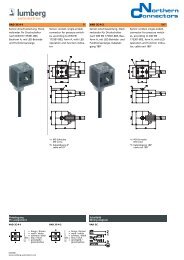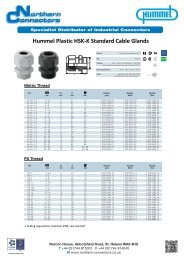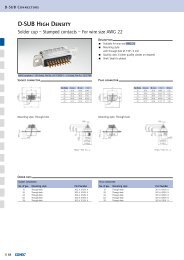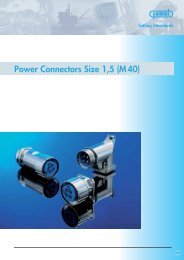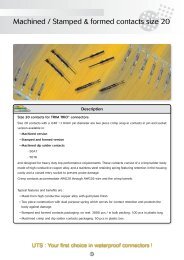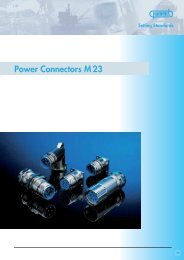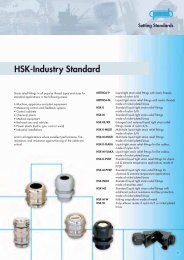HARTING - Northern Connectors
HARTING - Northern Connectors
HARTING - Northern Connectors
Create successful ePaper yourself
Turn your PDF publications into a flip-book with our unique Google optimized e-Paper software.
Terminations<br />
General<br />
information<br />
THT soldering technology<br />
The term "soldering" is defined in DIN 8505:<br />
"Soldering is a method of connecting metallic materials<br />
using an additional melting metal, if necessary with the assistance<br />
of a flux and/or protective gas. The melting temperature<br />
of the solder must lie beneath the minimum melting<br />
temperature of the base metals being connected. These<br />
base metals shall be tinned without melting themselves."<br />
Soft solders commonly used on electronic equipment are to<br />
DIN 1707-100. Todays lead free solders have a melting range<br />
between 217 °C and 227 °C depending on the composition of the<br />
alloy. For soldering metallic materials the flux is defined in DIN<br />
EN 29 454-1. Tests are explained in DIN 8526. For soldering male<br />
connectors into printed circuit boards, see recommendations for<br />
soldering on page 00.06.<br />
The components are positioned using pick-and-place machines.<br />
These automatic assembly machines differ according to whether<br />
the components are small, lightweight or bulky. <strong>Connectors</strong> are<br />
considered bulky (odd form) because of their comparatively heavy<br />
weight and large volume which makes them more difficult to grip.<br />
Furthermore, machines for odd form components must have<br />
higher insertion power to fit the components into pcb holes, which<br />
are filled with solder paste. As a rule, modern SMC production<br />
lines are equipped with both types of machine, therefore the<br />
"Pin in Hole Intrusive Reflow" process generally entails no extra<br />
investment costs for the user.<br />
Conventional assembly process:<br />
SMC soldering technology<br />
The continuing trend towards miniaturisation has<br />
revolutionised the assembly of electronic components. For the<br />
past 15 years, most components have been secured directly<br />
to the pcb surface by means of Surface Mount Technology<br />
(SMT). By dispensing with drilled holes on the pcb, a space<br />
saving of up to 70 percent is achieved.<br />
1. Application of solder paste<br />
2. Positioning the components<br />
3. Positioning odd form components<br />
4. Reflow soldering<br />
5. Pressing in or partially dip soldering the<br />
connector at the board edge<br />
6. Quality inspection<br />
Fig. 1:<br />
SMT board with connector for<br />
"Pin in Hole Intrusive Reflow" assembly<br />
“Pin in Hole Intrusive Reflow” assembly:<br />
1. Application of solder paste<br />
2. Positioning the components<br />
3. Positioning odd form components<br />
4. Reflow soldering<br />
5. Pressing in or partially dip soldering the<br />
connector at the board edge<br />
6. Quality inspection<br />
Today, typical components such as resistors, ICs, capacitors, and<br />
connectors with straight terminal pins are almost exclusively fitted<br />
using SMD (Surface Mount Device) technology in mass production.<br />
In contrast, angled SMD connectors at the edge of the board have<br />
not been successful because of tolerance problems (co-planarity)<br />
and stresses during mating. Modified solder connectors for<br />
assembly with "Pin in Hole Intrusive Reflow" process offer a better<br />
solution. These can be mounted at low cost, utilising existing SMD<br />
production lines.<br />
00 .<br />
20<br />
“Pin in Hole Intrusive Reflow”<br />
In this process, the connector is inserted into plated through holes<br />
in a comparable way to conventional component mounting. All<br />
other components can be assembled on the pcb surface.<br />
Fig. 2:<br />
Pick-and-place machine for<br />
odd form components<br />
(Courtesy of JOT Automation GmbH)


